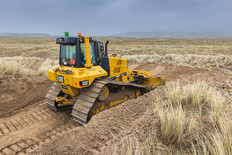
As the evenings begin to draw on and signs of spring starts to blossom, we can look back with pride on a successful season that saw the Sands of LIFE team complete a whole host of work across Wales.
At Kenfig we scraped an area within the dune slacks to remove the existing coarse vegetation and create bare sand habitat that is crucial to the survival of some of Wales’ rarest dune specialist wildlife.
We also removed scrub, such as birch and willow, species which if not controlled will take over in wet areas and spread further through the dunes and overgrow important dune slack and grassland habitats. Read more about our work at Kenfig.
At Pembrey Burrows we created three dune notches - or gaps in the front of the dune - and stripped turf from areas of dune grassland and low-lying dune slacks to expose bare sand. The work should also increase the natural movement of sand in the dunes. Read more about our work at Pembrey Burrows.
At Newborough we scraped about 0.4 ha at Gull Slack - one of the low-lying open glades in the forest near Penrhos Dunes. Scraping away overgrown vegetation helps to expose bare sand and create further damp habitat for native plants and invertebrates to inhabit.
Other winter tasks completed at Newborough included 5ha of mowing, 3ha of de-stumping and around 20ha of invasive non-native species and native scrub removal. Here is Leigh to provide more detail about our work at Newborough.
At Morfa Harlech we employed innovative robo-mowers on the dunes to cut back dense vegetation before enlisting the help of a four-legged spider excavator machine to climb the dunes and scrape the turf. This creates bare sand habitat for rare invertebrates and native wildflowers.
The work was completed in partnership with the Royal St. David's Golf Club who own the land where the conservation work is taking place. More information about our work at Morfa Harlech can be found in this Cambrian News article.
We also cleared 5ha of sea buckthorn at Laugharne-Pendine Burrows. Whilst native in eastern parts of the UK, it is non-native to Wales and is a highly invasive plant that smothers dune wildlife. It grows quickly into banks of impenetrable, thorny bushes, taking over native grasses and wildflowers.
|